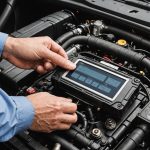Overview of Cold Air Intake Systems
Cold air intake systems are a popular modification for improving vehicle performance, particularly in the UK automotive market. At their core, these systems function by replacing the stock air intake with a redesigned pathway that pulls cooler, denser air from outside the engine bay. This air is richer in oxygen, facilitating a more efficient combustion process.
The main performance enhancements associated with cold air intake systems tend to be increased horsepower, improved throttle response, and potential increments in fuel efficiency. These benefits are especially noticeable in performance cars, where the stock air intake may restrict engine capabilities. Proper installation is vital to ensure these systems operate optimally. If installed incorrectly, they might fail to deliver the promised performance improvements or even cause engine issues.
This might interest you : Comprehensive diy rust repair manual: a step-by-step approach for restoring your uk vehicle
While the basics of these systems are relatively straightforward, it’s crucial to ensure compatibility with your vehicle, as each car model may have specific requirements. Furthermore, specialized installation tools may be necessary to achieve a precise fit, highlighting the need for both accuracy and care during the installation process.
Compatibility with UK Performance Cars
Ensuring that a cold air intake system is compatible with your UK performance car is crucial to leveraging its true potential. Different manufacturers and models come with varying design specifications, making it essential to verify model specifications before making a purchase.
Also to see : Ultimate uk guide to wheel and tire detailing: tips and techniques for car enthusiasts
Commonly compatible vehicles include popular performance car models like the Ford Fiesta ST and the Volkswagen Golf GTI. However, it’s not solely about the car make or model. Important compatibility factors include the engine type and model year. Vehicles from a similar line may have different configurations based on their production year, which can impact the cold air intake system’s fit and effectiveness.
Resources such as manufacturer websites or trusted automotive databases can offer insights into specific compatibility guidelines. Additionally, seeking advice from automotive forums or local workshops can further help in determining the right fit for your car model. Purchasing a non-compatible system can lead to inefficiencies or even performance drawbacks, hence thorough research is indispensable. By checking these factors in advance, you’ll ensure the benefits of enhanced throttle response and improved engine performance that a well-fitted system can deliver.
Tools and Materials Needed
Installing a cold air intake system requires specific installation tools and quality materials to ensure an effective DIY process. Proper tools are essential to both streamline installation and avoid potential damage.
Essential Tools
- Socket Set: A complete set ensures you’re prepared for different nut and bolt sizes.
- Pliers: Useful for gripping and removing various components.
- Screwdrivers: Necessary for loosening and securing screws in tight spots.
- Torque Wrench: Ensures bolts are securely fastened to manufacturer specifications.
Recommended Materials
Choosing the right materials is equally crucial. Look for stainless steel clamps and durable intake tubes. A quality filter element can significantly impact performance.
Tips for Sourcing Quality Components
- Visit automotive stores with good reputation for authentic parts.
- Check product reviews online to gauge quality and reliability.
- Consider purchasing from official dealer websites to ensure compatibility.
Investing in the right tools and materials upfront not only facilitates a smoother installation but assures the long-term benefits of your cold air intake system, enhancing your vehicle’s performance safely and efficiently.
Step-by-Step Installation Guide
Before diving into your DIY installation, ensure you have the proper tools and set aside time to tackle the project head-on.
Preparing Your Workspace
Creating a clean, organised workspace is crucial. Ensure you have all installation instructions and necessary tools at hand. It’s wise to park your vehicle on a level surface and engage the handbrake. Safety precautions are vital: wear gloves and safety goggles to prevent injury.
Removing the Existing Air Intake
To start, disconnect the battery to eliminate any electrical hazards. Identify the stock air intake system, usually linked to the throttle body. With a screwdriver, remove any clamps and fasteners securing it. Gently detach the hoses and electrical connections before lifting the old system out.
Installing the Cold Air Intake
Carefully follow the step-by-step guide provided with your new intake. Begin by positioning the intake tube in the engine bay, ensuring it’s secured with compatible brackets. Attach the filter element, and fix all hoses and connections as outlined in the installation instructions. Use a torque wrench to ensure proper tightness on all bolts.
Finally, reconnect your battery and perform a test drive, paying attention to improved throttle response and engine sound changes—key indicators of a successful installation.
Safety Precautions
Taking the right safety measures is crucial when installing cold air intake systems. Not only does attention to safety gear protect you, but it also ensures the successful implementation of your DIY project without incidents.
Essential Safety Gear
Wearing appropriate safety gear is non-negotiable. Consider the following items as part of your installation safety toolkit:
- Safety Goggles: Protect your eyes from debris and potential splash damage during the installation.
- Work Gloves: These help avoid cuts and provide grip when handling installation tools and materials.
- Work Boots: Sturdy footwear can prevent injuries from accidental drops or sharp object exposure.
Common Hazards
Beware of typical hazards associated with engine modifications. Electrical systems pose risks, so disconnecting the battery before starting is essential to avoid shocks. Also, engine components can become heated, making awareness of engine temperature crucial to prevent burns.
Post-Installation Safety Checks
Once the cold air intake system is installed, perform safety checks to verify secure connections and proper function. Inspect for any loose clamps or hoses that might lead to a malfunction or cause engine damage. Periodic maintenance is recommended to keep the system in optimum condition, safeguarding both performance and safety.
Potential Performance Benefits
Cold air intake systems can provide significant engine performance improvements. The primary advantage is the increase in horsepower gains. By introducing cooler, denser air into the engine, these systems maximise combustion efficiency, leading to noticeable power boosts. This increase is particularly beneficial for performance vehicles that often seek every additional horsepower for an edge.
Moreover, cold air intakes enhance engine efficiency. Cooler air results in better fuel combustion, which can potentially improve fuel economy. This is a favoured outcome for those looking to balance performance with fuel costs.
Another advantage is the improvement in throttle response. The engine can ‘breathe’ more easily, allowing for quicker acceleration and a more responsive driving experience. This modification is ideal for drivers who desire sharper, more immediate feedback from their vehicles.
Besides immediate power and efficiency enhancements, a well-chosen cold air intake can contribute to the long-term benefits of your vehicle. Reduced engine stress due to improved air intake can lead to engine longevity, offering a sustainable approach to maintaining high performance. Users not only enjoy immediate enhancements but also promote the vehicle’s overall health over time.
Troubleshooting Common Issues
Ensuring a properly functioning cold air intake system is crucial for achieving the desired performance gains. However, installation may sometimes lead to issues that require troubleshooting. One common problem is an unusual engine performance, which might suggest the intake system isn’t sealed correctly, leading to air leaks. To rectify this, check for secure connections and tighten any loose clamps.
When facing installation issues, look for signs like poor throttle response or a Check Engine light. These can indicate problems like incorrect fitting or a misaligned mass airflow sensor. Remedying these involves reviewing the installation instructions and adjusting the setup accordingly.
If engine overheating occurs, ensure the intake is free from obstructions and fits properly within the engine bay. Continual engine temperature fluctuations can signify the necessity of a re-evaluation of the installation process.
Regular maintenance helps alleviate performance troubleshooting. Cleaning the filter element and inspecting for wear and tear can prevent future problems. Adhering to these maintenance tips ensures your system continues to deliver efficient engine performance. In short, addressing issues promptly and adopting routine check-ups maintain the effectiveness and longevity of your cold air intake system.
Recommended Products and Resources
Choosing the right cold air intake systems can enhance your vehicle’s performance notably. Engaging with reputable brands ensures reliability and quality. Brands like K&N and AEM are known within the UK automotive market for delivering robust systems.
When selecting an intake system, consider your performance car’s compatibility—an aspect manufacturers often guide on their websites. Vehicle-specific options from brands like Cobb and Mishimoto are tailored for varied model specifications, ensuring a precise fit.
To aid in installation, utilise resources like instructional videos from trusted automotive YouTube channels. These can provide visual guidance step-by-step. Reading detailed reviews on automotive forums may offer insights into real-world performance enhancements and any potential pitfalls encountered.
For those needing further assistance, reaching out to local automotive specialists can be advantageous. Many workshops have the expertise in aftermarket modifications, providing not only installation services but also advice tailored to your vehicle’s specific needs. This combination of trusted products and accessible resources can ensure that your cold air intake system delivers the desired performance enhancements, safely and efficiently.











